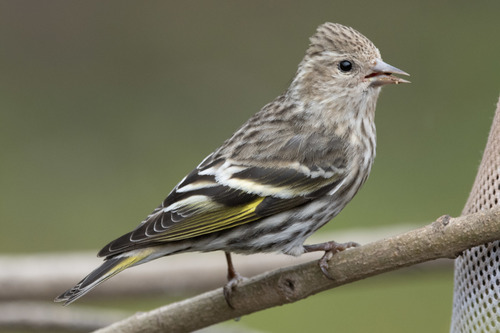
Pine Siskin
The Pine Siskin (*Spinus pinus*) is a small, streaky finch native to North America. It is known for its highly nomadic behavior, often irrupting in large numbers to areas far outside its typical range in search of food. This species plays an important ecological role as a seed disperser, particularly for coniferous trees. While not possessing strikingly colorful plumage, the Pine Siskin's energetic foraging and social behavior make it a fascinating subject for birdwatchers. It holds no particular cultural significance beyond its general appeal as a wild bird.
11-14 cm
Length
18-22 cm
Wingspan
Least Concern
Conservation Status
Distribution
The Pine Siskin breeds across a wide range of North America, from Alaska and Canada south through much of the United States. Its breeding range extends into the higher elevations of Mexico. It is a highly irruptive migrant, with wintering distribution varying greatly depending on food availability. It can be found from southern Canada throughout the US and into Mexico during winter.
Lifespan
Up to 9 years in the wild, although the average is likely shorter. Captivity data is limited.
Pine Siskin's Habitat
Habitat Types
Coniferous forests, Mixed woodlands, Suburban areas, Parks, Gardens
Climate Zones
Boreal, Temperate, Subtropical (at higher elevations)
Adaptations
The Pine Siskin's slender, pointed bill is well-suited for extracting seeds from cones. They are also agile climbers, allowing them to efficiently forage in treetops.
Variations
Three subspecies are generally recognized, *S. p. pinus*, *S. p. macropterus*, and *S. p. perplexus*, showing slight variations in size and plumage.
Appearance
Breeding Plumage
Plumage is generally similar year-round, though breeding birds may have slightly brighter yellow markings.
Seasonal Feather Changes
Limited seasonal variation.
Sex Based Plumage Differences
Males typically have more extensive and brighter yellow markings, particularly on the wings and tail, but there's considerable overlap with females.
Notable Features
Heavy streaking on upperparts and underparts., Yellow patches on wings and tail (variable in extent)., Sharply pointed bill.
Diet and Feeding
Primary Foods
Seeds (especially conifer seeds), Insects (particularly during breeding season), Buds, Nectar
Foraging Behavior
Pine Siskins are active foragers, often feeding in flocks. They cling to branches and cones, extracting seeds with their bills. They also glean insects from foliage and occasionally visit flowers for nectar.
Specializations
Their pointed bill is specialized for extracting seeds from cones. They can also store seeds in a throat pouch (a diverticulum of the esophagus) for later consumption.
Seasonal Diet Variations
Diet shifts significantly with the seasons. In winter, they rely heavily on conifer seeds. In summer, insects become a more important part of the diet, especially for feeding young.
Behavior
Social Structure
Highly social, especially outside of the breeding season. Often forms large flocks, sometimes mixed with other finch species.
Communication
Constant, twittering contact calls., A distinctive, rising *zweee* call., A buzzy, raspy song.
Migration
Pine Siskins are nomadic and irruptive migrants. Their movements are driven by food availability, particularly cone crops. Some years they may be abundant in areas where they are rare in other years.
Territorial or Group Behaviors
During the breeding season, males defend a small territory around the nest. Outside of breeding, they are highly gregarious.
Conservation
Threats
Habitat loss (particularly loss of mature conifer forests), Climate change (potentially affecting cone production), Collisions with windows, Disease (e.g., Salmonellosis at bird feeders)
Protection Programs
General forest conservation efforts benefit this species., Monitoring programs (e.g., Project FeederWatch)
Local National Laws
Protected under the Migratory Bird Treaty Act in the United States.
Population Trend
Fluctuating, but generally considered stable.
Population Estimates
Difficult to estimate due to irruptive nature. Partners in Flight estimates a global breeding population of 92 million.
Interesting Facts
Pine Siskins can survive extremely cold temperatures.
They can increase their metabolic rate to several times their basal rate to generate heat.
They are prone to outbreaks of Salmonellosis.
This bacterial disease can spread rapidly at bird feeders, highlighting the importance of regular cleaning.
Pine Siskins are known for their irruptive migrations.
These unpredictable movements are linked to the availability of their primary food source, conifer seeds, making them a somewhat elusive species to track.
Faqs about Pine Siskin
Why are Pine Siskins sometimes abundant one year and absent the next?
Their movements are driven by food availability, particularly cone crops. They are nomadic and irruptive migrants.
What should I do if I see sick birds at my feeder?
Take down your feeders and clean them thoroughly with a 10% bleach solution. Wait a week or two before putting them back up.
How can I attract Pine Siskins to my yard?
Offer Nyjer (thistle) seed and black oil sunflower seeds in tube feeders. Providing a source of fresh water can also be attractive.
Are Pine Siskins related to Goldfinches?
Yes, they are both members of the finch family (Fringillidae) and share some similarities in appearance and behavior, but they belong to different genera.
Copyright @ Nature Style Limited. All Rights Reserved.
 English
English